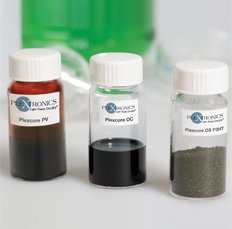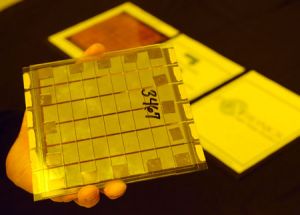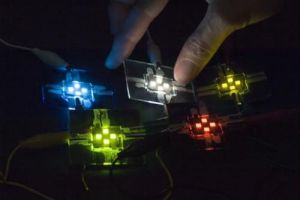 Back in 2006, we published an interview with Andy Hannah, Plextronics' president, CEO and co-founder. Andy agreed to do a follow-up interview to update us on Plextronics' business and technology.
Back in 2006, we published an interview with Andy Hannah, Plextronics' president, CEO and co-founder. Andy agreed to do a follow-up interview to update us on Plextronics' business and technology.
Plextronics is a US-based company (established in 2002, as a spin-out from Carnegie Mellon University) that is developing technology that enables broad market commercialization of organic electronic devices - including OLEDs, plastic chips, polymer solar cells and organic sensors.
Q: Andy, can you give us a short introduction to your OLED technology?
Q: The benefits of OLEDs include, of course, being printable, low cost and demonstrating enhanced device performance. Plextronics’ technology plays a key part in achieving these benefits by reducing operating voltage in devices and thereby increasing lifetime and power efficiency.

Plexcore® OC AQ was our first OLED ink introduced to the market. It is an aqueous-based ink that is designed to replace PEDOT in solutions polymer and solution-VTE hybrid stacks. It is formulated for ink jet printing or slot die coating.
Plexcore® OC NQ is our newest offering to the market. This non-aqueous-based Hole Injection Layer (HIL) ink complements our existing aqueous-based HIL, and is geared specifically for solution small molecule, phosphorescent OLED emitters. In early sampling, customers are seeing dramatic improvements in operating voltage and lifetime. We added NQ to our product portfolio because some customers required it for the processing environment in which they operate.
Plexcore® OC HTL this solutions processed HTL technology is currently under development with early sampling to select customers only. We started to develop this technology based upon requests from key customers and partners for a more manufacturing worthy, solutions processed HTL. When used with our Plexcore® OC NQ, Plextronics’ solutions processed HTL will enable the next level of lifetime breakthroughs for solution processed small molecule materials and represent the first fully tuned hole injection / hole transport ink system.
Q: Do you have any customers for your organic Inks? Are there any products available that use your materials?
Yes, we have customers using our Plexcore® OC inks today in pilot line operations and for development purposes. We expect to see our inks in sell through products over the next 2-5 years.
Q: In 2009 you installed a new production line (the 'D' line) that can make OLEDs (flexible ones, too). Any updates on that line? Are you still using it to produce samples?
We installed our Development Line (D-Line) in 2009 to demonstrate larger scale application of our inks and accelerate the development of manufacturing worthy inks. Development work in D-Line has been focused mainly on OPV device and ink engineering over the last couple of years, but this year we plan to begin transitioning to run more OLED lighting panels.
 Plextronics OPV module
Plextronics OPV moduleWe have completed several OLED lighting customer trials on the D-Line to explore processing of our inks in hybrid devices and optimize inks for use on their lines. We expect to do even more OLED lighting work on that line this year.
Q: Towards the end of 2010 you announced the new OC-NQ ink for solution processable phosphorescent OLED emitters. In the PR you mentioned that you expect to introduce ink-jet printable inks early in 2011. How is that progressing?
We are now sampling early ink-jet formulations to several key customers. Broader availability will be later this year, again to select customers and partners.

Q: Can you update us about your relationship with UDC? We know they are using your new ink in their research.
UDC published their latest P2OLED results in October 2010 and acknowledged the use of our NQ ink in achieving the results. We expect that UDC’s P2OLED platform will be an attractive offering to both OLED display and lighting companies in the coming years. We continue to develop our products to meet the requirements of this platform.
Q: You are also working together with Novaled on doped and solution processed organic materials for OLEDs. We heard from Novaled that you're making progress. Any updates there?
We continue to work with Novaled and explore how our technologies might work together to provide a breakthrough in device performance.
Q: Lately you announced a co-development effort with Cambrios (funded in part by the DOE) for transparent conduction hole injection (TCHI) electrode. Any updates on that?
We recently presented a project update at a DOE SSL workshop in February 2011, which was well-received. We are seeing good results combining Cambrios’ ClearOhm⢠nanowire-based material with our Plexcore® OC, and both companies are very pleased with the progress we've made. As a sneak peak to that progress...voltage performance of our devices is similar to ITO and, though at an early stage, we've seen good stability as well.
Q: In fact transparent OLEDs are exciting. When do you see such technology being brought in the market? We know that Samsung is interested in such displays.
Transparent OLEDs are exciting, but it’s difficult to predict whether they will be adopted in OLED display or lighting applications first.
Q: You are also working technologies that will enable flexible (and even bendable) displays/lighting panels. What are your views on the flexible OLED market? When can we assume that such panels can be actually commercialized?
One of the main issues with the adoption of flexible OLED, we believe, is the availability of acceptable barrier technology. We believe that the mass adoption of flexible displays/lighting will be largely dependent on this factor.
Q: Back in 2006 you seemed to focus on PLED displays. It seems that the market is geared towards SM-OLED these days. Which will be the leading material in the future?
We classify OLED technology into solution processed and vapor deposited. As display manufacturers move toward larger glass sizes, we are confident that solution processing will become the only viable manufacturing technique.
For lighting, we are seeing more and more companies pursing hybrid devices that use a combination of solution and vapor layers where typically the HIL is a solution layer. In our view, this is a stepping stone to all-solution processed devices.
As for materials, we have developed our technology platforms to work with both polymer and small molecule emitters. We don’t view it as prioritizing one technology over another, we just know that there are multiple options out there and we want to offer our customers as much flexibility as possible.
Q: Beside OLEDs, you are also working on inks for organic PV (solar) cells. What role will those cells make in the future?
Energy harvesting is the near term market opportunity for OPV. We've discovered that our organic materials work particularly well in indoor lighting environments, and ultimately can replace batteries in applications and devices like e-paper displays and wireless sensors.
Q: Back in 2006 you also discussed the possibility of creating organic and flexible transistors (for RFID and other applications). Are you still researching those applications?
While we still sell some materials for organic RFID, we chose to focus our development efforts in the OLED and OPV spaces.
Q: Back in 2009 you closed a $14 million financing round. Will you require more funding?
Yes, we are seeking additional capital over the next year to accelerate commercialization of our technology. We aren't publicly disclosing the amount of financing, but we’re confident based on discussions with several potential investors that we will be able to meet our financing needs.
Q: How do you see the OLED market (for both displays and lighting) in the next 5 years? What role will Plextronics make?
We want to be at the forefront of the transition from all vapor processing to partial and full solutions OLED. Working with key partners, we expect to develop inks and inks systems with associated process know-how to help our customers implement scalable, manufacturing worthy processes.
Andy - thank you for this interview. I wish both you and Plextronics the best of luck!

